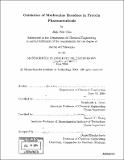Oxidation of methionine residues in protein pharmaceuticals
Author(s)
Chu, Jhih-Wei, 1973-
DownloadFull printable version (10.04Mb)
Other Contributors
Massachusetts Institute of Technology. Dept. of Chemical Engineering.
Advisor
Bernhardt L. Trout and Daniel I.C. Wang.
Terms of use
Metadata
Show full item recordAbstract
(cont.) of free methionine. Therefore, the environments surrounding different methionine sites in G-CSF mainly provide spatial restriction to the access to the solvent but do not affect oxidation in a specific manner, consistent with the good correlation between 2SWCN's and the rates of oxidation. A comprehensive picture of oxidation is thus developed. It allows an accurate prediction of protein oxidation, and provides a rationale for developing strategies to control oxidation, such as modulating protein conformation via adding excipients. This knowledge could aid in developing in a more rational manner solvent formulations that protect therapeutic proteins against oxidation. Oxidation of the amino acid methionine by peroxides in aqueous formulations of proteins is a critical issue in the development of therapeutic products. It must be controlled so that therapeutic proteins can maintain their activity. In addition, oxidized therapeutics are undesirable due to their possible immunogenetic effects. An understanding of the mechanism and the factors that influence the reactivity of different methionine sites toward oxidation is therefore important. In this thesis, computational methods are applied and developed to address these problems. First, a mechanism by which peroxides oxidize the sulfur atom of methionine is developed. The rate-limiting step was found to be the breaking of the O-O bond of H₂O₂ and the formation of the S-O bond during which significant charge separation is developed. The charge separation can be stabilized via specific interactions such as hydrogen bonding with surrounding water molecules. This "water-mediated" mechanism of oxidation is consistent with experimental data such as those on activation energies of oxidation and pH dependence of the rates of oxidation. Based on the "water-mediated" mechanism, a structural property, average 2-shell water coordination number (2SWCN), has been shown to correlate well to the rates of oxidation of different methionine groups in Granulocyte Colony-Stimulating Factor (G-CSF) and in a Human Parathyroid hormone fragment (hPTH(1-34)). Including the dynamics of protein and water molecules in an explicit manner was found to be important for such correlation. Via combined quantum mechanical and molecular mechanical free energy simulations, the activation free energies of the oxidation of methionine residues in G-CSF are found to be equivalent to the values for the oxidation
Description
Thesis (Ph. D.)--Massachusetts Institute of Technology, Dept. of Chemical Engineering, 2004. Includes bibliographical references (p. 171-189).
Date issued
2004Department
Massachusetts Institute of Technology. Department of Chemical EngineeringPublisher
Massachusetts Institute of Technology
Keywords
Chemical Engineering.